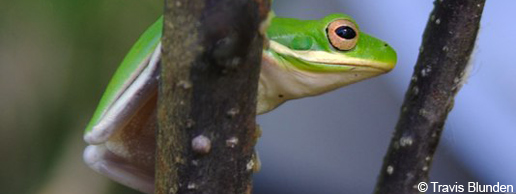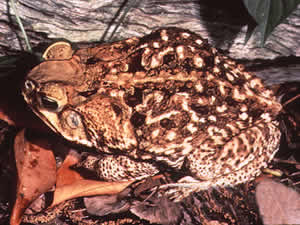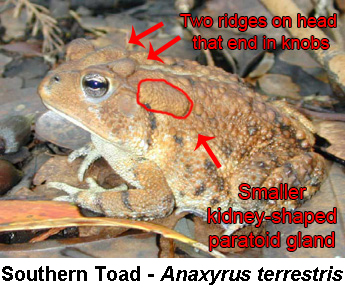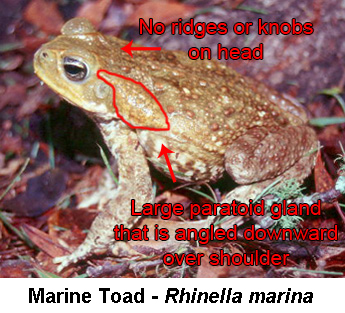
Marine Toad
Rhinella marina
(formerly Bufo marinus)

Description: The Marine Toad (a.k.a. Giant Toad or Cane Toad) is the largest of the toads found in Florida. The Marine Toad is not native to the United States. It was originally released in the U.S. in sugar cane fields to help control “white grubs,” larvae of pest Scarabaeidae. Rhinella marina (formerly Bufo marinus) became established in southern Florida as result of accidental release of about 100 specimens from the stock of a pet dealer at Miami airport in 1955, and by subsequent releases by pet dealers in the 1960s (Krakauer, 1968). Marine Toads are a highly predacious exotic species that will eat all types of native frogs and toads. This species is skilled at locating all types of food, they have even been known to eat pet food.
Reproduction: The Marine Toad breeds year-round in standing water, streams, canals and ditches.
CAUTION: When this non-native species is threatened or handled, it secretes a highly toxic milky substance from its large parotoid glands at the back of its head, behind the ears. This secretion can burn your eyes, may irritate your skin, and can kill cats and dogs if they ingest the secretion.
Symptoms of Marine Toad poisoning in pets include drooling, head-shaking, crying, loss of coordination, and, in more serious cases, convulsions. The dog's (or cat's) gums often turn red, an indicator used by veterinarians to distinguish toad poisoning from epilepsy. For this reason, pet owners should be familiar with their pet's normal gum color. Treatment: If you suspect toad poisoning, get a hose and run water in the side of the dog's/cat's mouth, pointing the animal's head downward so water isn't swallowed. Rub the gums and mouth to remove the toxin. This treatment is usually successful, but call your veterinarian immediately.
For more information about the Marine Toad, please see our free publications entitled "Marine Toads (Bufo marinus)" (in HTML and PDF) and "Marine Toad - Quick Reference Sheet" (in PDF). You can also write us Email at extension@ wec.ufl.edu, or send regular mail to Mark Hostetler, Extension Wildlife Specialist, Dept. of Wildlife Ecology and Conservation, PO Box 110430, University of Florida, Gainesville, FL 32611-0430.
Call: Its call is a low-pitched trill and a chorus that sounds like an idling diesel engine.
Click HERE to listen to the call of the Marine Toad.
(A new browser window will open with the sound file)
The native Southern Toad (Anaxyrus terrestris) is sometimes mistaken for the Marine Toad. Here are a few ways to tell these toads apart:
- The Marine Toad has very large paratoid glands. The Southern Toad has smaller kidney-shaped paratoid glands, which secrete a substance that may be irritating to mucous membranes but is not toxic.
- The Southern Toad has two ridges on its head that end in knobs. The Marine Toad does not have these.
- The adult Southern Toad ranges in length from 1.75 to 4.5 inches. The adult Marine Toad ranges in length from 4 - 6 inches.
 |
 |
Credit: USGS/Florida Integrated Science Center
Development of these pages was a cooperative effort. Photos were supplied by Barry Mansell Photos and calls were provided by Paul Moler, state herpetologist for the Florida Fish and Wildlife Conservation Commission.


 Location: http://yourdomain.edu
Location: http://yourdomain.edu